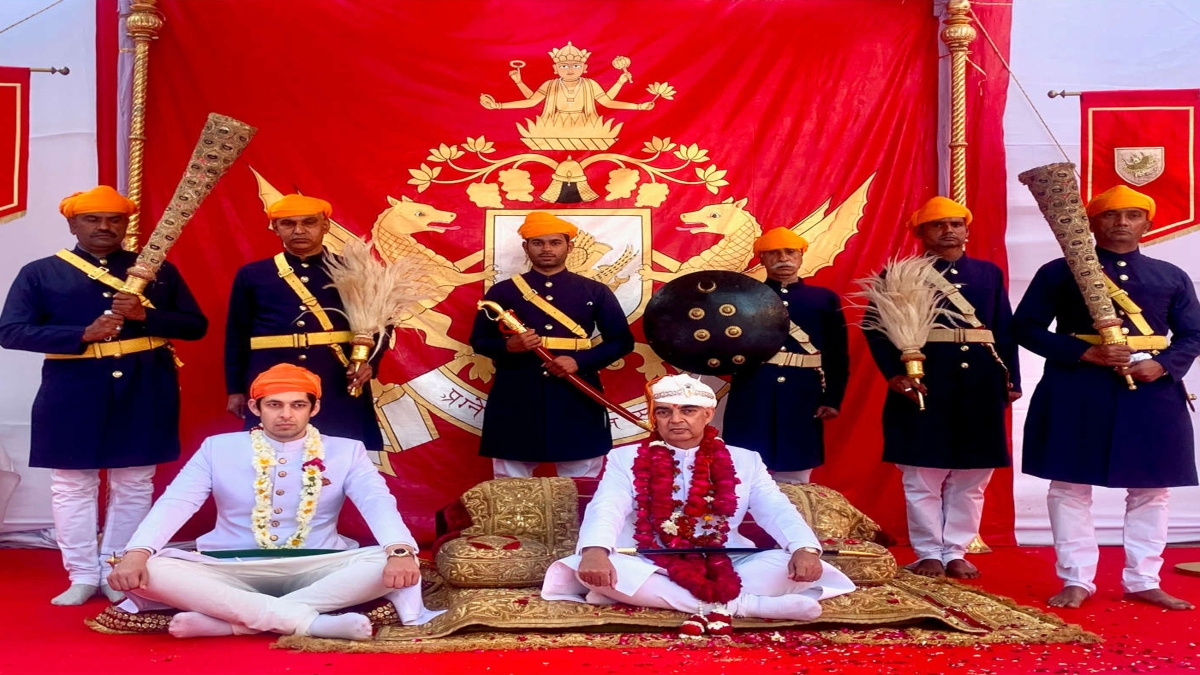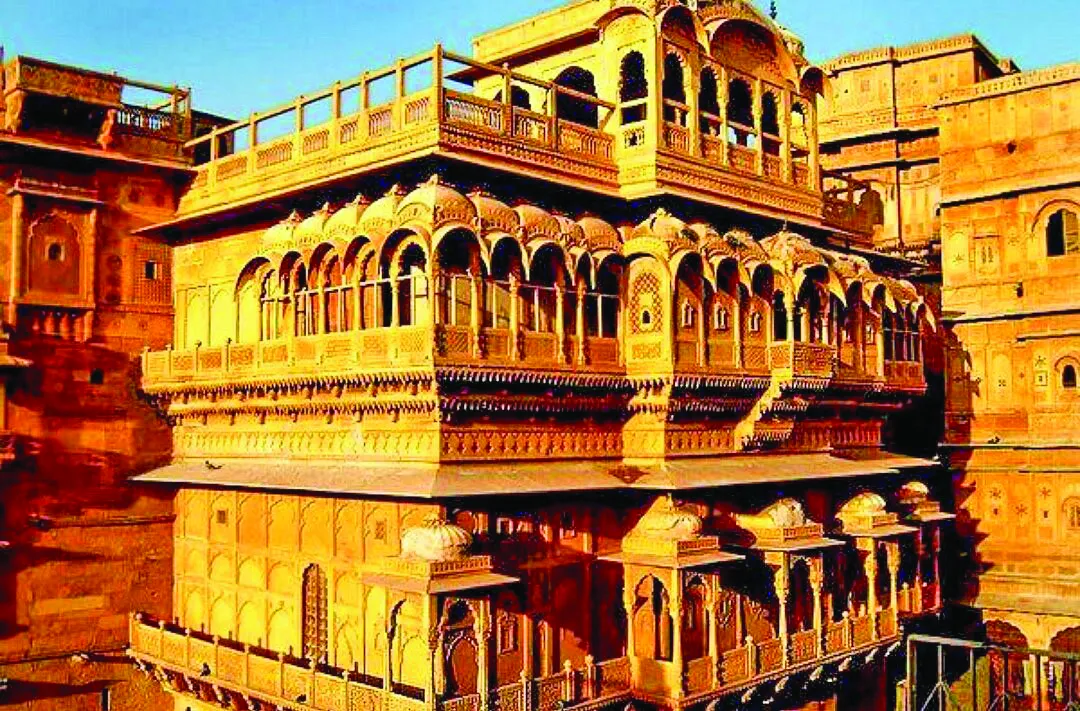The recent Rajtilak at Kotah heralded royal revelry, fanfare and pageantry that were truly reminiscent of an era gone by. Following the demise of the late HH Maharao Saheb Brijraj Singhji, his son and heir, Ijyaraj Singh was anointed as the 19th Maharao of Kotah in a private yet spectacular ceremony at the Rajmahal Chowk within the 13th Century Kotah-Garh complex on 10 February. An air of regal grandeur prevailed as almost 250 jagirdars representing over 50 thikanas of the erstwhile kingdom of Kotah gathered into the Garh precincts to reiterate their allegiance. Dressed in all white Jodhpuris and bandhgala suits they donned white or dull coloured paags or headgear before taking their assigned seats as per palace protocol.
 Maharao Ijyaraj Singh with his family members including Rajmata Uttara Devi, wife Maharani Kalpana Devi and son MK Jaidev Singh after the culmination of the Rajtilak ceremony.
Maharao Ijyaraj Singh with his family members including Rajmata Uttara Devi, wife Maharani Kalpana Devi and son MK Jaidev Singh after the culmination of the Rajtilak ceremony. Ladies assemble at the Bhim Mahal to witness the Rajtilak ceremony.
Ladies assemble at the Bhim Mahal to witness the Rajtilak ceremony. Some of the members from the Thikhanas of the former Kotah State.
Some of the members from the Thikhanas of the former Kotah State. Maharao Ijyaraj Singh, Maharani Kalpana Devi & MK Jaidev Singh along with royal family retainers stand at the entrance to the Kotah-Garh complex.
Maharao Ijyaraj Singh, Maharani Kalpana Devi & MK Jaidev Singh along with royal family retainers stand at the entrance to the Kotah-Garh complex. Jagirdars representing the Thikhanas of Kotah line up at the Rajtilak at the Kotah–Garh complex.
Jagirdars representing the Thikhanas of Kotah line up at the Rajtilak at the Kotah–Garh complex. Maharao Ijyaraj Singh and his son Maharaj Kumar Jaidev Singh seated under the Royal Canopy during the Rajtilak ceremony.
Maharao Ijyaraj Singh and his son Maharaj Kumar Jaidev Singh seated under the Royal Canopy during the Rajtilak ceremony.
The headgear in Rajasthan has timelessly served as a symbol of regional identity. The Kotah Paag proudly remains symbolic of the Kotah’s age-old traditions and heritage. The late Maharao Brijraj Singhji was himself a staunch proponent of the Kotah Paag and encouraged its prevalence amongst the people of Kotah. Thus, there couldn’t be a more befitting tribute than one in which almost all of the jagirdars had opted to sport this particular headgear.
The ceremony commenced with Ijyaraj Singhji first visiting the temple of his family’s kuldevta—Shri Brijnathji and paying obeisance to the deity. The Royal priest then tied the saffron coloured patka onto his white paag, denoting that the Lord has given colour to the new Maharao. This sacred gesture ritually marks the end of the mourning period. Thereafter, he entered the Rajmahal Chowk accompanied by a small retinue of uniformed retainers bearing the royal standard, insignias, fly whisks and the royal chatri. He took up his position under the grand royal canopy. Flanking it on either side were the resplendent Kotah coat of arms. Kotah’s royal insignia is dominated by the garuda bird at the centre that is accompanied by a flying dragon on each side.
The former kingdom of Kotah was accorded a 17- gunsalute status and was amongst the larger of the 22states that comprised pre-independence Rajputana. The royal family of Kotah hail from the Hada clan, an offshoot of the Chauhan dynasty, and trace their lineage to the Hindu king Prithviraj Chauhan. In 1948, Kotah was integrated into the Union of India by its last ruler HH Maharao Bhim Singhji, who signed the instrument of accession of his state into India. Hence, on the right of the canopy were seated the chieftains from the same Hada clan including members from the thikanas of Bamulia, Palaitha, Rajgarh, Koela, Kotda, Sangod, Amli, Napania, Ratawad, and Chamlasa amongst others. On the left were seated representatives from other Rajput clans, close family members and other special guests and dignitaries.
First on the agenda was the customary rang ka dastur that involves the changing of colours from subdued mourning hues to brighter colours. This too marks the end of the mourning period. The first to present the saffron paag to Ijayraj Singhji was Indradeep Narayan Banerjee from Bankura and the official representative of the Cooch Bihar royal family. This was followed by Maharaj Jai Singh of Suket. A simultaneous practice of the rang ka dastur was conducted at the Bhim Mahal amongst all the attending ladies. Incidentally, it was for the first time that ladies of the royal family and all thikanas witnessed the Rajtilak and the Rajyabhishek ceremonies. They were formerly barred to witness public occasions due to the widely prevalent purdah system. Breaking away from such archaic customs is a possibility and prerogative of the modern era. The rang ka dastur was followed by the rajtilak ceremony. The rajpurohit (head priest) and other senior royal priests preluded by anointing Ijyaraj Singhji with tilak and showered their blessings. This was followed by the rajyabhishek. Once the religious proceedings had culminated it was time for the nazar and satkars to be performed by all the jagirdars. These are primarily social gestures on behalf of the erstwhile jagirdars who acknowledge the anointing of the new ‘Maharao’ as a gesture of reposing their loyalty and allegiance to him.
The historic 13th century Kotah-Garh or the City Palace has been a pivotal venue to the town and the community at large. The late Maharao Brijraj Singhji converted a section of this into a museum in 1970. The Rao Madho Singh Museum houses a fine collection of royal regalia, arms and armour, textiles and object d’art. The age-old traditions and customs in erstwhile Royal households are prevalent to this day. Socially, they continue to be relevant and are regarded in high esteem by their former Jagirdars. The overwhelming support and turnout at the recent Rajtilak of Maharao Ijyaraj Singh is just one of the many instances that go to prove this point.























